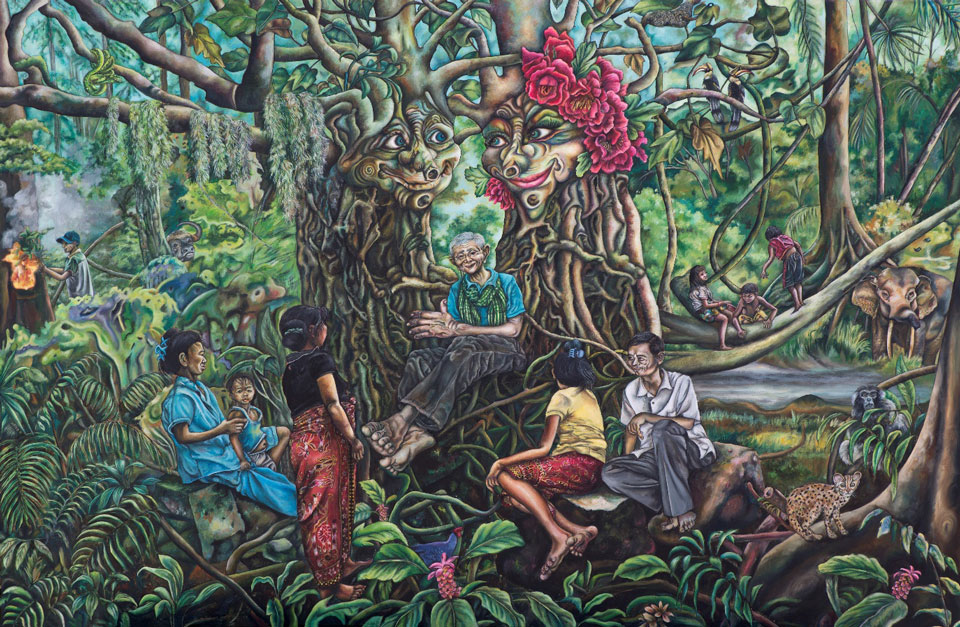Situated across the provinces of Kratie, Preah Vihear, Steung Treng and Kampong Thom, Prey Lang forest contains 8 types of distinctive habitats as well as several landforms and over 400 animal species in which 17 species are endangered animals and plants. It is home to an extensive biodiversity and several ecosystems of important ecological, cultural and economic value. It is among the largest lowland evergreen forests in the Indo-Burma Hotspot1, and it has been called one of the top 10 most important landscapes in the world for its ecological value.
Prey Lang
It means "Our Forest" in Kuy language, the main minority living in Prey Lang.
340
villages
250,000
people
50%
of vertebrate
diversity in
Cambodia
Prey Lang is mostly inhabited by indigenous people. It is estimated that 700,000 people are living within 10km around the forest.
The forest is host to an extensive
biodiversity, although threatened and in decline. It remains the largest evergreen forest of Cambodia and in the Indo-Burma Hotspot.
Photo: Supporting Forests and Biodiversity (SFB), USAID
Prey Lang has gained increasing interest from international NGOs, along with active involvement by the local Prey Lang Community Network (PLCN). East West Management Institute, was one of the main organizations that supported gathering communities together around the forest.
Prey Lang: One Forest. One Future. By East-West Management Institute (EWMI)
Prey Lang in development
The precise landscape boundaries remain unclear and are currently a major topic of discussion at a time when the Ministry of Environment is establishing the Prey Lang Wildlife Sanctuary.2 For more information, refer to Prey Lang Protection. It is challenging for people to advocate for the protection of a land without defined borders.
In addition, roads that have been constructed since 2008 have made remote places such as Prey Lang accessible for people and companies.3 This has led to increasing resource extraction, which was already happening extensively throughout Prey Lang. The forest is increasingly being opened up, which causes tremendous changes and poses questions for the future of its wildlife, indigenous people and habitats.
Resource extraction
NTFPs
80%
of the forest’s households rely on resin collection
Company investment
24 ELCs covering
288,525 ha
11 Mining concession.
Prey Lang possesses valuable resource, essential for community livelihood. It has recently been massively invested on, for its timber resource and richness of its soils.
Photo: Supporting Forests and Biodiversity (SFB), USAID
Indigenous people and growing public awareness
Prey Lang is mostly home to the Kuy indigenous people. It is a place of much traditional significance for Cambodians, contributing to the raising of public awareness for its protection. Indigenous people have been living in the forest for generations, and the place is of the utmost cultural importance.4 It is estimated that around 700,000 people are living within 10km of Prey Lang.5

Photo: Grandfather in Prey Lang. Supporting Forests and Biodiversity (SFB). USAID.
The Prey Lang Community Network recently gained international attention, and was acknowledged and rewarded during the COP21 environmental summit in 2015.6 The network contributes to the forest’s protection by reporting illegal activities.7
References
- 1. Winrock International, Conservation International. (2015). “Biodiversity Assessment of Prey Lang”. http://preylang.net/download/PL-Biodiversity-Assessment-Report.pdf
- 2. Aun Pheap, Zsombor Peter. (2016). “Government Expands Sanctuary in Prey Lang, Adds Preah Vihear”. The Cambodia Daily, 18 May 2016. Accessed 14 October 2016. https://www.cambodiadaily.com/archives/govt-expands-sanctuary-in-prey-lang-adds-preah-vihear-112723/
- 3. A. Olsson, D. Emmett. (2007). “A Floral and Faunal Biodiversity Assessment of Prey Long” Conservation International. http://preylang.net/download/reports/PL-Floral-and-Faunal-Biodiversity-Assessment.pdf
- 4. Terry Parnell. (2015). “Story-telling and social change. A case study of the Prey Lang Community Network”
- 5. Ibid
- 6. Charles Parkinson. (2015). “Prey Lang network wins Equator Prize”. The Phnom Penh Post, 22 September 2015. Accessed 14 October 2016. https://www.phnompenhpost.com/national/prey-lang-network-wins-equator-prize
- 7. D. Argyriou, A. Tistan, I. Theilade, C.Vogt, C. Turreira Garcia, P. Mitterhofer, S. Brofeldt. “The current status of Prey Lang” 4th Monitoring report.

